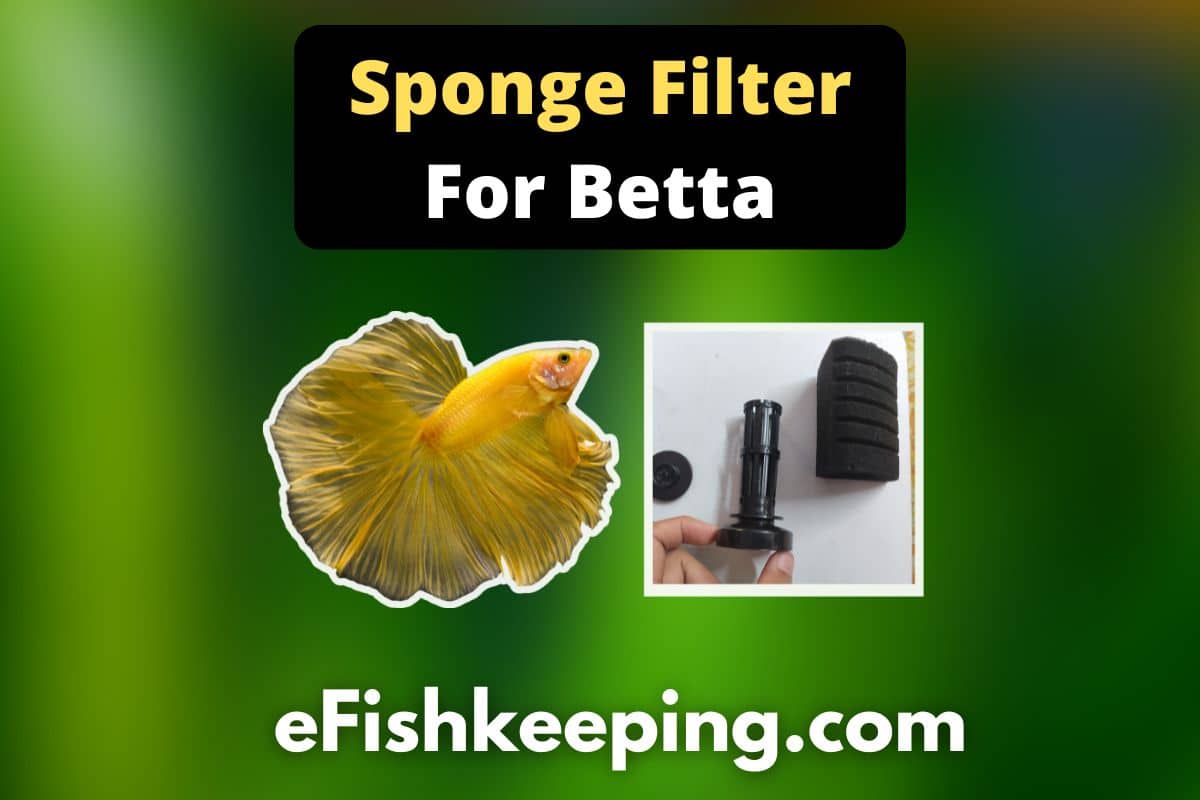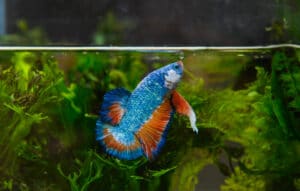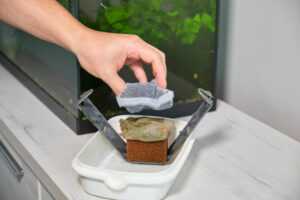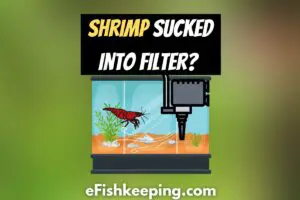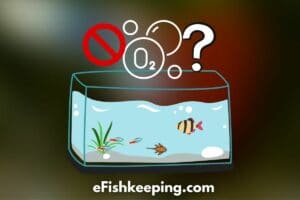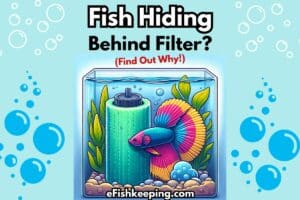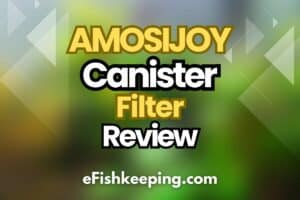Sponge filters are one of the best choices for your lovely betta fish.
Here’s a quick overview of the best sponge filters for betta:
| Sponge Filter For Betta: | Size: |
| AQUANEAT Mini Sponge Filter | 0.5-3 Gallons |
| Hygger Super Mini Sponge Filter | 0.5-5 Gallons |
| AQUANEAT Corner Sponge Filter | 20-40 Gallons |
| UPETTOOLS Aquarium Biochemical Sponge Filter | 5-40 Gallons |
For detailed information about each of these filters and other helpful information about sponge filters for betta tank, continue reading till the end!
What Is A Sponge Filter?
A sponge filter (as the name suggests) is a filtering device used in aquariums that comes with a sponge.
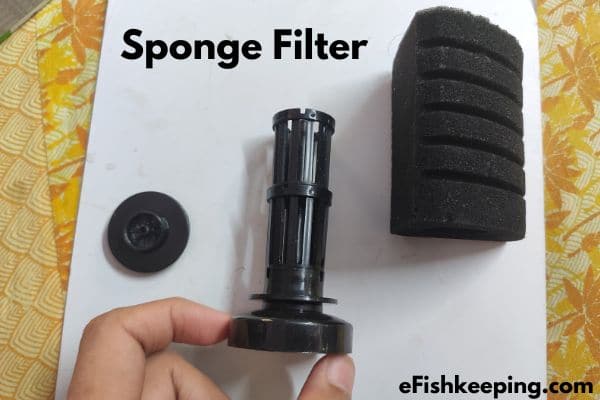
There is no electricity used in ‘directly’ running the sponge filter. It is just a device with the main body and the outer covering of a sponge.
The airline tubing is connected at its top from where it gets the airflow.
So then, which equipment uses electricity? Well, it’s the air pump that is kept outside of the tank, and that pumps air to the sponge filter using electricity.
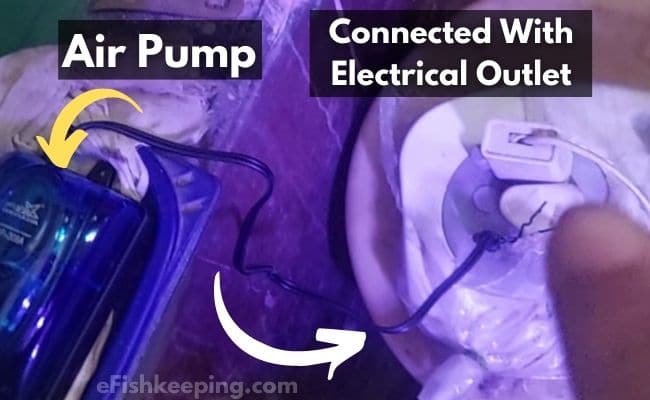
What Is The Best Sponge Filter For Betta?
| Sponge Filter For Betta: | Overview: |
| AQUANEAT Mini Sponge Filter | Ideal For Small Betta Tank |
| Hygger Super Mini Aquarium Sponge Filter | Suitable For Small Betta Tank + Hanging Feature Available |
| AQUANEAT Corner Sponge Filter | Perfect For Medium/Big Betta Tank + Can Be Fit Perfectly In Corner + Design Is Different |
| UPETTOOLS Aquarium Biochemical Sponge Filter | Perfect For Medium/Big Betta Tank + Hanging feature Available + Additional Chamber For Bio Ceramic Media Balls |
Important Note: Generally speaking, most sponge filters online may not come with an air pump unless stated otherwise. So be sure to check if you already have one.
And if you don’t, look no further than the Tetra Whisper Aquarium Air Pumps. They are optimized for operating quietly.

(You can click the above image to check the shown item on Amazon)
One of the significant concerns with the air pump is the noise that comes along with it. But Tetra Whisper Aquarium Air Pump, you can’t go wrong. It is considered one of the quietest air pumps on the market.
Just be sure to check the right one based on your tank size. For your ease, here I have made a table:
| Size: | Link (To Amazon): |
| up to 10 Gallons | Check Price |
| 20-40 Gallons | Check Price |
| 40-60 Gallons | Check Price |
| 60-100 Gallons | Check Price |
Once the air pump thing is cleared, you’ll also have to look for other items needed for the setup.
You may get items like airline tubing, control valves, and suction cups with sponge filters.
So, in that case, you can skip the ones you are already getting with the pack. But rest, be sure to have all the items by your side so that you don’t run into any problems while doing the setup.
Here’s a checklist of items needed for setting up the sponge filter:
Now that we have an overview of what’s needed let’s take a closer look at the sponge filters.
Here’s a list of the best sponge filter for bettas:
#1. AQUANEAT Mini Sponge Filter

(You can click the above image to check the shown item on Amazon)
- It is a small sponge filter that takes quite less room in the tank.
- Since it is small, it is not an ideal option for bigger tanks.
- The recommended tank size for this sponge filter usage is 0.5-3 gallons.
- You will get a control valve, an airline tubing (nearly 40 inches), and a sponge filter. So you may not need anything extra if you already have an air pump and a check valve.
Who Should Choose This Sponge Filter?
If you have a small betta tank (up to 3 gallons), and if you want something simple, small, that can do its job without any hassle, this sponge filter is made for you!
Check Price Here (on Amazon)
#2. Hygger Super Mini Aquarium Sponge Filter

(You can click the above image to check the shown item on Amazon)
- As the name of this sponge filter suggests, it is pretty small in size.
- The recommended size up to which you can use this sponge filter is from 0.5-5 gallons.
- In addition to the sponge filter, you’ll get an additional spare sponge which is interesting. Having a sponge in a spare can be handy at times if, for some reason, you would have to change the sponge 😉
- And you’ll also get a suction cup using which you can easily hang the sponge filter in your aquarium.
Who Should Choose This Sponge Filter?
You should get this sponge filter if you have a small betta tank (up to 5 gallons). For a small tank, this would be perfect since it is quite small. In addition, you can easily hide it and thus maintain your tank’s aesthetics.
An added benefit is the ability to hang it inside your tank anywhere easily as you wish.
Being super small (so that it won’t look odd) and an easy placement option makes this sponge filter one of the best choices for small betta tanks.
Check Price Here (on Amazon)
#3. AQUANEAT Corner Sponge Filter

(You can click the above image to check the shown item on Amazon)
- Unlike other sponge filters, this is designed specifically to be set at the corner portion of your fish tank.
- There are two available sizes for this sponge filter. One is for tanks up to 20 gallons, and another is for tanks up to 40 gallons. (So make sure to select the correct size while purchasing the product)
- Along with the sponge filter, you get a 4ft airline tubing, a control valve, tee, non-return check valve, and four suction cups. So that means if you have an air pump, you don’t need to buy anything extra.
Who Should Choose This Sponge Filter?
If you have a betta tank of the size that is relatively bigger (about 20 gallons or so), and you want something that can snugly fit in the corner of your tank, this is your perfect choice.
Check Price Here (on Amazon)
#4. UPETTOOLS Aquarium Biochemical Sponge Filter

(You can click the above image to check the shown item on Amazon)
- You may be bored with regular black-colored sponge filter designs. However, this UPETTOOLS sponge filter has a slightly different design, as seen in the above picture.
- This filter is recommended for tanks of 5 gallons or more.
- Along with the sponge filter, there’s also a chamber in this filter, as you can see where the bio ceramic media balls are being kept, which assists in filtration and the growth of helpful bacteria.
- The air-water outlet is entirely adjustable, so no worries if you want to point the water in another direction.
- Along with a sponge filter, you get two bags of ceramic balls; two pare sponges and two suction cups.
- Using two suctions cups, you can hang and attach this filter anywhere in your aquarium.
Who Should Choose This Sponge Filter?
If you have a relatively bigger tank (5-40 gallons), looking for a unique design, hanging capability, and the additional feature of bio media balls, this sponge filter is made for you!
Check Price Here (on Amazon)
Are Sponge Filters Good For Bettas?
Sponge Filters are good for bettas because they offer gentle flow in the fish tank. As a general rule, bettas don’t prefer fast-flowing water. However, since you can adjust the flow of the sponge filter using control valves, they become the perfect choice for your betta tank.
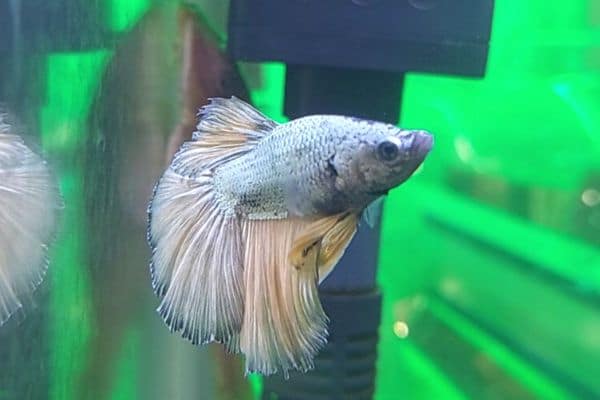
Bettas typically have gorgeous and delicate fins. So Putting them in a fast-flowing water system won’t be great.
Also, in nature, bettas are usually found in shallow marshes, ponds, and slow-moving streams. As you can imagine, shallow water sources like rice paddies or ponds don’t have much water movement or flow.
So by nature, betta fish are used to living in water sources without much movement.
And the job of us aquarists is to provide our fish the best kind of environment that relates nearest to one they have in the nature.
There are filtration systems like Powerhead attached to the top filter of the aquarium. It gives heavy flow in the tank, which your betta would surely hate 😀
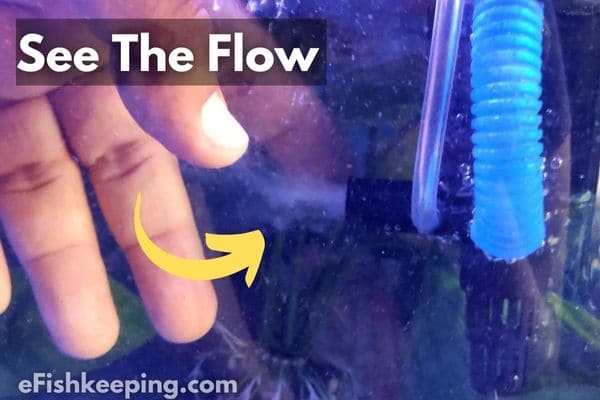
Overall, among all other filters, the sponge filters can be considered as the one with a gentle flow.
Once you set it up with the air pump and with proper valves, you can easily control the flow. Thus, you can control the water movement as per your wish, making the sponge filter one of the best options for the betta.
And not just that, a sponge filter has many other benefits.
Pros Of Sponge Filter
- It is pretty inexpensive as compared to other filters in general.
- There is no complex mechanism involved. Only has a sponge and the body structure in the filter. So rest, all you must do is connect it with an air pump through an airline tubing.
- Since the filter is so simple, the repair or replacement process is also quite simple. With sponge filters, you don’t have to deal with any electrical components or too many mechanical parts.
- It is quieter as compared to most other filters. A sponge filter does offer water movement at the surface, but you can adjust the flow through control valves. And the sound produced is not that much compared to those made by powerheads or other filters.
- It goes well with other filter types. No matter what filter you have, if there’s space available in the tank, you can surely slide in a sponge filter to enhance the filtration of your tank water.
- It goes well with almost all types of aquariums. Whether you have a small, medium, or large tank, freshwater tank, planted tank, or shrimp-only tank, the sponge filter goes well with all. Just make sure to select the correct size suitable for your fish tank.
- Since the sponge filter is a simple system that doesn’t have many technicalities, cleaning and maintaining them is easy.
- You can use it as a pre-filter. Already have a hang-on back type or canister filter? Then you can add a block of sponge foam at the filter’s intake. That way, you can enjoy most of the advantages you would get from a sponge filter.
Sometimes small shrimps can get sucked into the filter. In that kind of situation, the pre-filter also acts as a protective barrier.
Cons of Sponge Filter
- They don’t offer you chemical filtration in the tank. However, they do offer mechanical and biological filtration. If you are looking for mechanical, chemical, and biological filtration, you will have to use power filters (also known as the hang-on-back filter).
Chemical Filtration mainly helps in dealing with short-term issues like getting rid of medications after you have used them or purifying the tap water before you put it in the tank. As a general rule, if you have a healthy tank, you don’t need chemical filters like activated carbon.
- They may or may not look appealing in terms of the aesthetics of your aquarium. You may not enjoy the looks of your aquarium after placing an oversized sponge filter in between. So, it is subjective, and that’s totally up to you. Personally, we do like sponge filters, and that’s why we have them in our betta tank.
Tip: You can smartly plan the placement of the sponge filter such that it may not come in the way of your tank’s main points of attraction 😉 You can use a corner sponge filter that fits snugly in the corner of your fish tank.
How To Setup A Sponge Filter For Betta Tank?
Here’s How To Setup A Sponge Filter For Betta Fish Tank:
- Have all the equipment by your side, like an air pump, airline tubing, control valves, and the sponge filter.
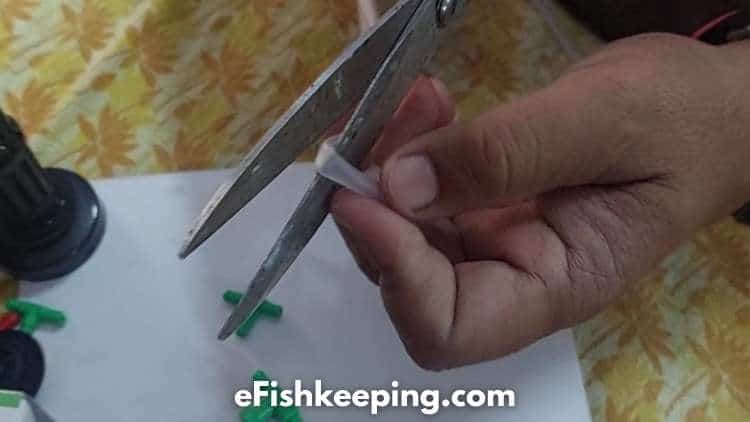
- Roughly measure the length of airline tubing you’ll require and cut that much pipe’s length. (You have to approximately measure the distance between the sponge filter and air pump)
An air pump is placed outside of the tank. Read this guide to know more about air pump placement for aquariums.
On the other hand, the sponge filter goes inside the tank. So obviously, it won’t make sense to have lots of extra airline tubing and try hard to hide it later on. Hence, I advised you to cut the tube length only as much as you need.
Once you are ready with this, move on to the next steps.
- Make another cut (somewhere between) the airline tubing and attach the control valve.

(You can click the above image to check the shown item on Amazon)
Why? Well, to attach the control valves.
You can also attach the check valves and for which you can make additional cuts to give extra room to it.
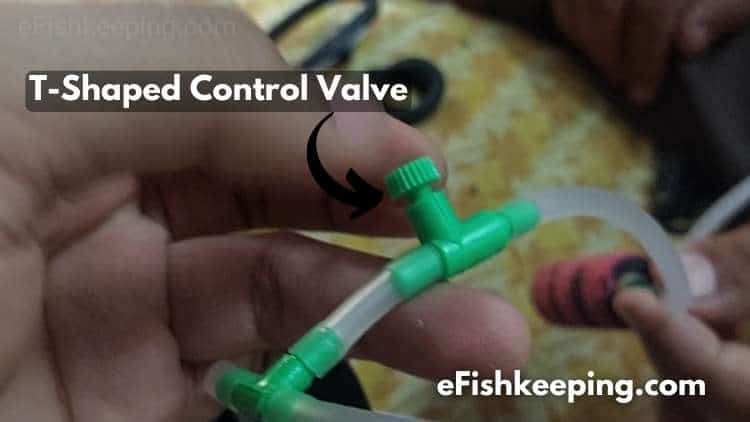
- Finally, connect the airline tubing with the air pump and the other end with the sponge filter.
- Connect your air pump with a power source and place the sponge filter inside the tank.
- Turn on the power of your air pump. Once the air pump starts working, the air will be pumped in flow through the sponge filter. Thereby, you can see the sponge filter in action!
So that’s how you can set up the sponge filter for your betta tank.
I have also made a full dedicated video on setting up a sponge filter, air stone, and the air pump. You can watch it to get a better idea of the things:
Do Bettas Need Sponge Filter?
Bettas don’t need a sponge filter to survive if you can keep the tank clean and do adequate water changes. Bettas have a specialized organ called a labyrinth that enables them to intake surface air. However, a sponge filter is recommended for having a long and healthy life of your betta.
Here’s a table that summarizes the situation of keeping betta fish without a sponge filter vs. with a sponge filter.
| Without Sponge Filter: | With Sponge Filter: |
| Betta Can Survive | Betta Can Live Happily |
| More Maintenance Efforts | Maintenance Needed But Relatively Less |
| Other Oxygenation Sources May Be Needed | Oxygenation Source Is Already Present |
A sponge filter will help you filter the tank’s water and provide oxygenation in the tank by surface agitation.
If you can keep the water movement right, there’s no other significant point to worry about sponge filter. It won’t harm your betta, so why not have it in your aquarium?
In our home aquarium also, we have kept a sponge filter for the betta fish. And so far, we haven’t noticed any issue.
So I would recommend having one sponge filter or at least any type of filter that won’t bother your betta. Trust me, your betta will thank you, and you will also enjoy the vibe of your tank after installing it. But it’s totally your choice, no pressure 😉
Final Thoughts
In short, if you have a very small betta tank and don’t want too much water movement, you can either have AQUANEAT Mini or the Hygger Super Mini sponge filter. However, you can choose AQUANEAT Corner or the UPETTOOLS Sponge filter for relatively bigger tanks.
And sponge filter is definitely a recommended option for your betta. The only thing is you have to be mindful that you are not selecting a powerful one. And if there’s any flow adjusting scope (like the control valve setup), that’s an added benefit!
I hope this guide has given enough information to set up and choose the right sponge filter for your betta.
I wish you a great day ahead with your betta 🙂
Subscribe to my YouTube channel (search eFishkeeping) if you are interested in watching my fishkeeping-related videos.
Read Also: Why Is My Whisper Filter So Loud?
Hi! I’m Praveen Ghoshal, the founder of eFishkeeping.com. Inspired by my Dad, I got interested in fishkeeping when I was a kid. Since then, I have been involved with this hobby. Currently, I have 3 fish tanks at our home, and I enjoy this hobby with my full family. Read more about me here.

